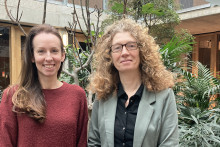It’s one of society’s weird places: elevators. Packed with people who do not know where to look or what to say. And so we just hope everything is over soon. Communication expert Mark van Vuuren (BMS faculty) explains the phenomenon of ‘elevator awkwardness’.
‘You could see the elevator as a pressure-cooker,’ states the Associate Professor. ‘It’s a place where two distinct social routines collide. On the one hand, you are in the presence of strangers for a very short time. In such situations, you normally remain silent. On the other hand, you stand so close to one another in a claustrophobically small space, invading each other’s private space, that you cannot ignore each other. This is the social dilemma of elevators.’
Generally, we solve this tension by what Canadian sociologist Erving Goffman described as ‘civil inattention’. That is the mundane, yet subtle balancing act between contact and avoidance, or as Goffman states: ‘One gives to another enough visual notice to demonstrate that one appreciates that the other is present (and that one admits openly to having seen him), while at the next moment withdrawing one's attention from him so as to express that he does not constitute a target of special curiosity.’ For the remainder of the ride you just look into the direction of the door.
‘Small talk is difficult in elevators,’ says the Associate Professor. ‘You cannot talk too loud, as others have to listen to you as well. But whispering suggests that you are hiding a secret. So we cultivated the unspoken conclusion that co-silence is the best solution.’ As a consolation, Van Vuuren adds, awkward silences often feel longer than they really are.
But there are also other ways of dealing with elevator awkwardness, says Van Vuuren, in the form of breaching our social conventions. ‘It’s what Professor Harold Garfinkel was known for in the field of ethnomethodology, the methods people use to understand and produce the everydayness of social life. He asked his students to break those rules to see what happened. So if someone enters the elevator next week and asks if he can stand in your place, you are probably part of an experiment. Compared to these interactions, a short moment in silence is far less awkward. All thanks to our capabilities of civil inattention.’







